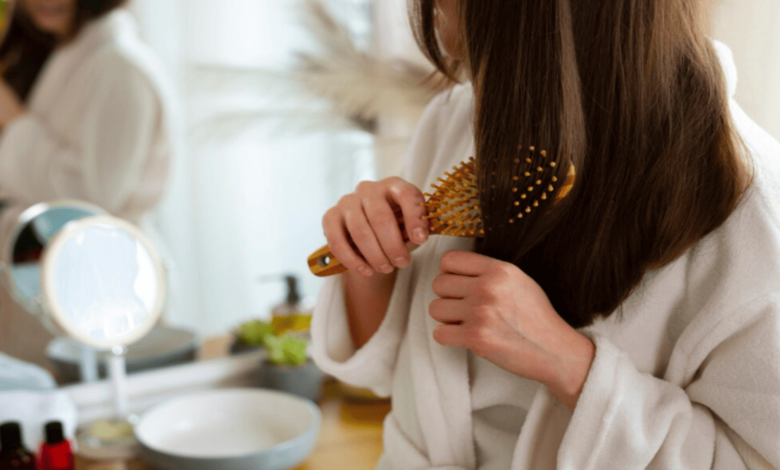Hair care Routine Based on Your Hair Type and Requirements

Have you ever been in the pharmacy section with frizz-ball-sized hair and worried that picking the incorrect shampoo might cause even more follicular chaos? Have you ever flipped through Instagram, admiring someone’s hair that shines like fluid diamonds and wondering if their flawless locks are the result of pure luck or something that regular people can achieve? Do not panic, my fellow mane-tamers! Find the contact number of a star hairdresser or a costly remedy to unlock your own happy, healthy hair. It involves doing away with the one-size-fits-all strategy and creating a hair care regimen specific to your hair type and requirements.
Are you prepared to say goodbye to bad hair days and welcome your greatest hair yet? Prepare to unravel the mystery of your hair, discover the ideal product posse, and experience the power of a customized hair care regimen! Get ready, gorgeous, because we’re going to change your hairstyle, one little step at a time
Recognizing Your Hair Type:
1. Texture of Hair:
- Straight: silky fibers that are barely bent or that fall flat. Detangles easily and is often fine or medium in thickness.
- Wavy: Slightly curved hair that is loose and unclear. able to be thick, medium, or fine.
- Curly: coherent coils or spirals that maintain their original form. Sometimes thick, and sometimes loose, bouncy, or tight.
- Coily: Z-shaped hairs packed thickly that coil or kink tightly. It is extremely thick and prone to dryness.
How to Determine Your Texture:
- To view your hair in its original state, rinse it without using any style products and let it air dry.
- Pinch a strand: Curly strands possess a unique spring, coily strands feel tightly coiled and coarse, and straight strands are smooth. Wavy strands feel a little rough.
- Find out patterns: Curly hair has definite spirals, coily hair has strong coils or kinks, wavy hair has loose waves, and straight hair falls straight.
2. Porosity of Hair:
Minimal porosity: cuticles that are closely packed and repel moisture. Hair may feel glossy but not readily absorb cosmetics.
Medium Porosity: well-balanced cuticles that gently retain and absorb moisture. Hair feels manageable and silky.
Increased porosity: Moisture can enter cuticles quickly and can also readily exit them. Frizzy, dry, and brittle hair can occur.
How to Determine Your Porosity:
Test of Strands: After cleaning, submerge a strand in water. It has high porosity if it sinks rapidly. Its porosity is low if it floats. It is medium porosity if it is in the middle.
Test for Bleach: Hair with a high porosity level will lighten quickly and readily. It has minimal porosity if it can withstand lightning.
3. Type of Scalp:
- Greasy scalp: produces too much sebum, which makes hair lank and oily. prone to scalp acne and dandruff.
- A dry scalp: reduces sebum production, which causes dry hair and an irritated, flaky scalp.
- Touchy Scalp: Redness and irritation are the result of an easy reaction to products and styling methods.
Identifying Scalp Types:
- Look at your scalp: Sensitive scalps may be red or itchy, whereas oily scalps appear shiny and greasy and have visible flaking.
- After going several hours without cleaning, touch your scalp: Sensitive scalps may feel tingling or uncomfortable, dry scalps will feel scratchy, and oily scalps will feel greasy.
Recall that as you age, your hormones change, and the environment affects you, your demands and your hair type may also alter. You can modify your regimen for the best possible hair care by periodically reevaluating your hair and scalp.
Evaluating The Needs for Your Hair:
1. Damage:
-
Split Ends:
Noticeable frayed ends of the hair shaft brought on by mechanical stress (rubbing and combing) and heat.
-
Breakage:
Breaking or falling hair strands, frequently as a result of extreme style techniques, protein deficiency, or dryness.
-
Lack of moisture:
Insufficient hydration within the hair shaft results in brittleness, frizz, and dullness. caused by elements such as strong shampoos, heat styling, and weather.
-
Frizz:
Roughness and undesired flyaways are frequently brought on by dehydration, humidity, or poor styling.
2. Desired Result:
-
Glow:
A healthy sheen comes naturally from the hair. You may want methods and items that increase luster.
-
Volume:
Hair that is fine or limp may benefit from volumizing shampoos, lift-adding trims, or style methods.
-
Manageability:
Dry hair, frizz, and knots can be challenging to control. Select tools and methods that detangle, smooth, and manage frizz.
-
Growth:
A customized regimen won’t significantly change your natural pace of hair growth, but some products and techniques can help maintain healthy scalp conditions, which in turn encourage healthy hair development.
3. Aspects of Lifestyle:
-
Regularity of Laundry:
How often you wash your hair has an impact on the moisture balance and oil production on your scalp. Think about your activity level and hair type.
-
Habits of Heat Styling:
Your hair may get damaged by frequent heat styling. Reduce your exposure to heat and make the most of your routine with heat protectants.
-
Exposure to the Environment:
Hair can be harmed by pollutants, wind, and sun. When required, wear protective products and hairstyles.
Comprehending these variables will enable you to customize your regimen to target particular issues and accomplish your intended hair objectives. Recall that patience and consistency are essential for long-term success!
Creating a Hair Care Schedule:
1. Cleansing up:
Selecting the Appropriate Items:
The most important step in your process is selecting the ideal shampoo and conditioner combination. Think about your needs and hair type:
-
Straight or Curved:
Choose solutions that are mild and devoid of sulfates to prevent frizz and dryness. Conditioners with more volume can increase the body.
-
Coily/curly:
Put your attention on deep conditioners and shampoos that are designed to hydrate curls. Steer clear of harsh substances that deplete natural oils.
-
Dehydrated/Injured:
Choose moisturizing, nourishing shampoos and deep conditioners that contain keratin or shea butter.
-
Oily:
Use clarifying shampoo sparingly as it can help get rid of extra sebum. Apply a gentle conditioner exclusively to the ends as a follow-up.
2. Conditioning:
Deep Conditioning:
It’s an essential part of the hair care routine to give your hair a weekly spa treatment by using a deep conditioner, It’s so essential. This is particularly beneficial for hair that is coily, dry, or damaged. For more hydration and repair, opt for masks that are high in proteins and emollients.
Leave-in Conditioners:
Your heroes of the day! Leave-in conditioners moisturize, detangle, and reduce frizz. For finer hair, use lighter solutions; for coarser textures, use heavier formulas.
3. Styling products:
-
Heat-resistant materials:
A must for anyone who works with heat tools! These shields prevent heat-related harm. Select non-greasy solutions based on the type of hair you have.
-
Styling Items:
Mousses, gels, and serums provide definition, hold, and structure. Choose mousses for volume, gels for hold, and serums for gloss and frizz management based on the results you want. Keep your hair, especially the finer strands, from being overdone.
4. Additional treatments:
-
Scrubs for Scalp:
To get rid of product accumulation and dead skin cells, massage your scalp. can aid in the treatment of dandruff and encourage healthy hair development. Only use them once every two to four weeks.
-
Hair Masks:
Consider using an intensive hair mask for specific issues like color fading, damage, or dryness. Select formulae that contain particular elements to meet your requirements.
-
Hair Oils:
A multipurpose tool for controlling frizz, reducing dryness, and providing shine. Avoid the scalp and use sparingly to the ends and mid-lengths of hair. Coconut, jojoba, and argan oils are well-liked options.
Recall:
- Begin with a simple regimen and progressively add products as required.
- Pay attention to your hair’s response and modify your routine accordingly.
- When it comes to styling products, less really is more. Use carefully; do not let it build up.
- Prioritize quality before quantity! Select premium products that are designed to work with the type of hair you have.
- The secret is to be consistent! For best results, follow your regimen.
Advice and Techniques for a Successful Hair Routine:
1. Massage of the scalp:
- Benefits: Increases blood flow to the scalp, encourages hair development, eases stress, and even relieves headaches.
- Method: For five to ten minutes, gently massage your scalp in circular strokes with your fingertips. Concentrate on various regions while using light pressure. This can be done a couple of times a week or every day.
2. Gentle Detangling:
- Why This Is Important: Damage and breakage may result from careless detangling.
- Top Techniques: Apply a gentle upward motion to damp hair by beginning at the ends with a wide-tooth comb or detangling brush. For more glide, use a detangling spray or leave-in conditioner.
3. Using Air to Dry:
- Benefits: Reduces heat damage, encourages natural volume, and adds gloss to protect hair health.
- Success Advice: Squeeze any extra water out gently using a microfiber cloth. For focused drying, utilize a diffuser attachment in a low-heat setting. If using heat is necessary, start by applying a heat protectant.
4. Internal and External Hydration:
- Internal Hydration: It’s important to stay well-hydrated throughout the day for both your hair and general health. Try to get a proper diet and 8–10 glasses each day.
- External Hydration: Hair oils, hydrating sprays, and deep conditioning treatments can all help keep your hair hydrated and avoid dryness. Select items according to the needs and kind of your hair.
5. Frequent Trims:
- Advantages: Keep your haircut professional, encourage healthy development, and stop split ends from moving up the hair shaft and creating damage.
- Frequency: For the majority of hair types, aim for trims every 6–8 weeks. You could require them more frequently if you are prone to split ends.
Conclusion:
And that’s it! Your customized road map for hair care is out for grabs. Recall that the secret to getting the nicest hair you’ve ever had is to embrace the particular requirements of your magnificent strands rather than taking a one-size-fits-all method. Once you discover what causes your hair to sing, don’t be hesitant to switch up your regimen, try new products, and experiment. This is a love letter to your hair at the end of it all a voyage of self-discovery and an acknowledgment of your uniqueness. Now take your go-to detangler, turn up the music, and get ready to embrace your inner alchemist for hair care! One gorgeous strand at a time, your hair will be grateful to you for it.




